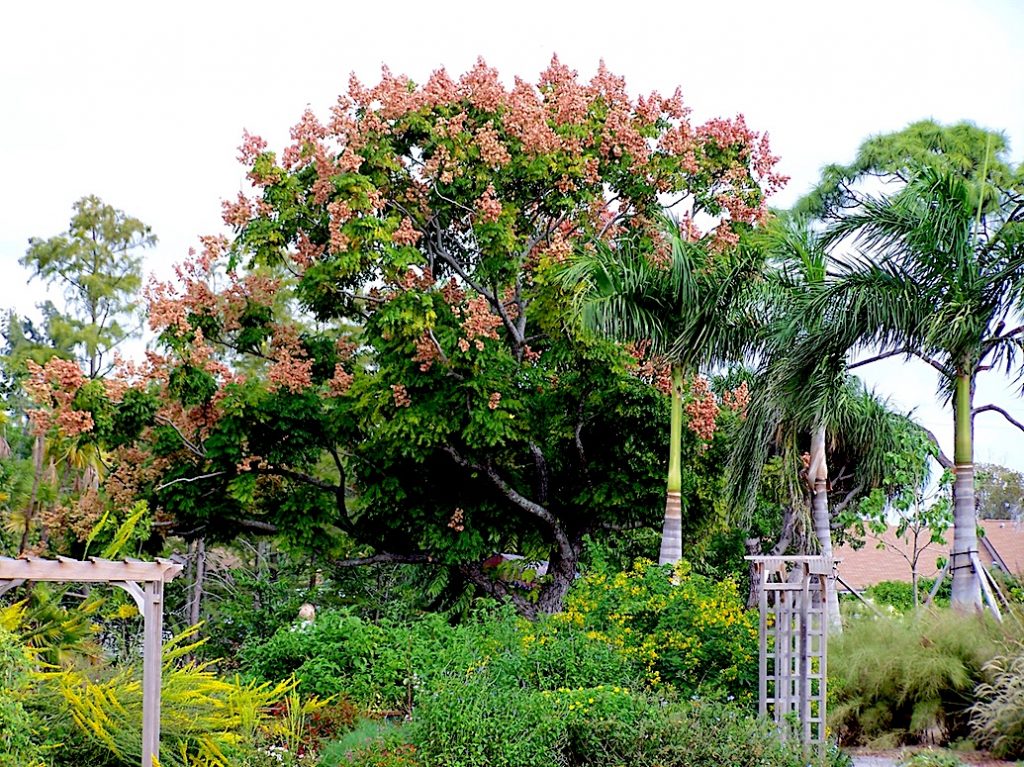
Golden Rain Tree, Mounts Botanical Garden, Palm Beach County.
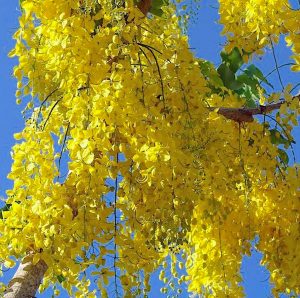
Yellow flowers create yellow seeds pods that then turn pink.
The tree is easy to find but is it edible? The answer is yes, maybe, barely. It depends on which part you’re referring to. The problem is the more edible parts are around when you don’t notice the tree — spring time — and the least edible parts are around when you do notice it. Thus I never quite get around to knowing all that the Golden Rain tree has to offer. In the spring it has tender young shoots and leaves. They are edible after cooking. Don’t try them raw, they have a bit of cyanide in them. Months later in the fall the seeds are reported as a famine food, not exactly a glowing endorsement. In between the yellow flowers are used for a dye as is the bark. Those boiled leaves and shoots do have some antioxidant and anti-tumor capacity but the research is slow making it way out of arcane journals to common knolwedge. As for the seeds… they are kind of in the same position as the particular mustard seed which is used to make Canola Oil. They are edible but like unrefined Canola Oil they can be irritating. What I might try to do is collect some seeds, sprout them, boil them, and give them a try… but let me do that first instead of you. You can read about the Golden Rain Tree here.
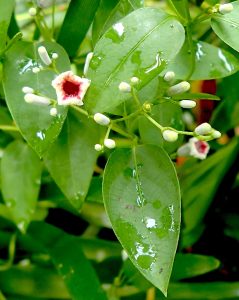
Skunk Vine lives up to its name. Photo by Green Deane
Perhaps as a last gasp — virtually — some Skunk Vine was blossoming this past week (along with some Black Cherries. See last week’s newsletter about out-of-seasoning blossoming.) Skunk Vine is aptly named though its aroma drifts more towards bathroom than skunk. However the tough vine is something of a nutritional powerhouse with some of the good chemicals one finds in the Brassica family. You can eat it raw but if you cook it outside is recommended. Oddly it was intentionally brought to Florida to make rope. This was done just before 1900 when a lot of ships were still carrying sails and miles of rope. Ground zero was the USDA Brooksville Field Station in Hernando County Fl. Yes, this invasive vine — like many other species — was imported by the United States Department of Agriculture. Thirty-six years later it was all over Florida but it took until 1977 for it to be a recognized invasive (long after it had crawled into other southern states.) While the blossoms are attractive we eat only the leaves and young tips. You can read about Skunk Vine here.
It’s a topic that concerns foragers: The fact that animals use the outdoors as their bathroom. There are some reasons for concern and some reasons not to be too concerned.

Jervey Gantt Dog Park, Ocala. Photo by Green Deane
I noticed some 60 years ago that wherever our dog Sister piddled on the lawn — what we had of it — the grass died. (She was called Sister because I didn’t have a sister.) The reason given for the grass death is a high urea content which is essentially a nitrogen overload. As a fertilizer a little dog piddle goes a long ways. Since we tend to not eat dead grass or the like it really isn’t a problem. Inside the home it’s the ammonia component that can irritate lungs and offend the nose. But outside most urine degrade fairly quickly and is not known for carrying a lot of long-lived bacteria. This is not so with other off-loaded material. Pets can be a source of varying diseases, bacterial to parasitical. Cat scat is among the most common domestically. Your feline’s deposits in your backyard can cause problems particularly to young children who are pretty close to the ground and what in it. Ditto dogs. And to be more specific it is the scat of primarily meat eaters that is more of a problem that other animals. Indeed, horse, cow and aged chicken manure was and in some places still are the fertilizers on many farms. Where I grew up slightly aged horse manure was favored for tomatoes. Cow manure was stronger and chicken manure was way to strong to use fresh. It would kill plants. Use some common sense: Don’t forage in a dog park.
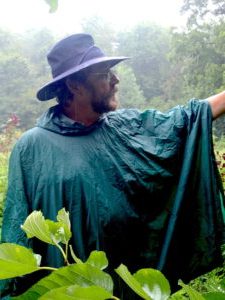
Classes are held rain or shine.
Upcoming foraging classes: This week is a busy week on the teaching schedule. Among the activities I have a class in Ft.Pierce on Saturday at 94-acre George LaStrange Preserve. It about two miles east the I-95/Florida Turnpike interchange in Ft Pierce. I hold classes there only once or twice a year because the location has no running water or official bathrooms. It does have a very clear, spring-fed 37-acre lake and borders on Ten Mile Creek which becomes the St. Lucie River. Then Sunday I have a class in Jacksonville on the campus of Florida State College, Beach Boulevard. It’s always the first area where I see our winter plant visitors popping up.
Saturday, November 11th, George LeStrange Preserve, 4911 Ralls Road, Fort Pierce, FL, 34981. 9a.m. The preserve is only about three miles from the junction of the Turnpike and I-95. We meet at the parking lot. This site had no formal bathrooms.
Sunday, November 12th, Florida State College, south campus, 11901 Beach Blvd., Jacksonville, FL., 32246. 9 a.m. We will meet at building “D” next to the administration parking lot.
Saturday, November 18th, John Chestnut County Park, 2200 East Lake Road, Palm Harbor, FL 34685. 9 a.m. Meet at the trail head of the Peggy Park Nature Walk, pavilion 1 parking lot.
Sunday, November 19th, Boulware Springs Park, 3420 SE 15th St., Gainesville, FL 32641. 9 a.m. Meet at the picnic tables next to the pump house.
Sunday, November 26th, Blanchard Park, 10501 Jay Blanchard Trail, Orlando, FL 32817. 9 a.m. Meet by the tennis courts near the WMCA building.
Sunday, December 3rd, Dreher Park, 1200 Southern Blvd., West Palm Beach, 33405, 9 a.m. We meet just north of the science center.
For more information about the classes click here:

Green Deane DVD Set
All of Green Deane’s videos available for free on You Tube. They do have ads on them so every time you watch a Green Deane video I get a quarter of one cent. Four views, one cent. Not exactly a large money-maker but it helps pays for this newsletter. If you want to see the videos without ads and some in slightly better quality you can order the DVD set. It is nine DVDs with 15 videos on each for a total of 135 videos. Many people want their own copy of the videos or they have a slow service and its easier to order then to watch them on-line. The DVDs make a good gift for that forager you know especially on long, cold winter months. Individual DVDs can also be ordered or you can pick and choose. You can order them by clicking on the button on the top right hand side of this page. Or you can go here.

The forum covers a variety of foraging topics.
Want to identify a plant? Looking for a foraging reference? Do you have a UFO, an Unidentified Flowering Object you want identified? On the Green Deane Forum we chat about foraging all year. And it’s not just about warm-weather plants or just North American flora. Many nations around the world share common weeds so there’s a lot to talk about. There’s also more than weeds. The reference section has information for foraging around the world. There are also articles on food preservation, and forgotten skills from making bows to fermenting food. One special section is “From the Frightening Mail Bag” where we learn from people who eat first then ask questions later. You can join the forum by clicking on “forum” in the menu.
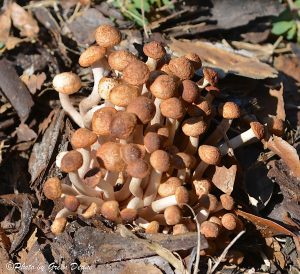
Ringless Honey Mushrooms. Photo by Green Deane
It is time to revisit Ringless Honey Mushrooms at least one more time for the season. They are among the easiest of edible wild mushroom to identify locally. You still have to be careful and take precautions which includes a spore print. That is when you cut off the stem off a mushroom and put the cap gills down on a piece of paper or glass for a few hours. The cap, if it is the right age, will drop spores. Collectively they will have a color. In this case it should be white. That separates the Honeys from other brown wood-liking mushrooms that can kill you. Every time I harvest Honeys I still do a spore print even though I am sure I have the right identification. It’s just a good habit to get into. Honeys are also cespitose, that is all growing out of one spot and either on a tree, stump, or buried root. The tree can be alive or dead. However if it isn’t dead the Honeys will kill it. Now is prime time locally for Ringless Honey Mushroom. There are some precautions about eating them. They should be thoroughly cooked — more so than most mushrooms — and it is recommended you don’t drink alcohol with them. You can read about them here.
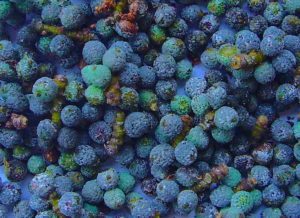
Southern Wax Myrtle Berries. Photo by Green Deane
Just because you can do something doesn’t mean you should. Can you make a bayberry candle? Absolutely. Should you? If you have to, yes. If not you might want to reconsider. Southern Wax Myrtle berries are small. They have a little wax on them which is why the species name is cerifera — wax producing. But it takes many gallons and a lot of hot work to get enough bayberry wax to mix with tallow (75/25) to make the famous smokeless candle that keeps away insects. No doubt a hundred years ago it was worth it. Not so much today. But, you can use the dried berries as a spice and the leaves like bay leaves or to make a tea. To read more about the Southern Wax Myrtle go here.
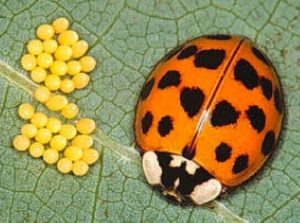
Ladybug and Eggs
While harmless to humans, masses of the multi-colored invaders are a deemed a nuisance when they slip in homes through cracks around doors and windows. They can also stain curtains, upholstery and walls if squashed. A spike in the ladybug population is typical this time of year as they fly out of the farm fields where they help control other insects and seek a warm place to spend the winter. In their native Asia — yes Ladybugs are not native — they usually overwinter in cliffs. The absence of cliffs attracts them to buildings. Mild winters followed by rainy springs can create the perfect environment for the species — the Multicolored Asian Lady Beetle — to flourish. Ladybugs are not edible but if you want to know about edible insects go here.
This is issue 277. The main portion of the website is now functional though small bugs persist. We are working on them. Thanks for you patience.
If you would like to donate to Eat The Weeds please click here.


Comments on this entry are closed.
Testing